Related Research Articles

Electronic voting is the standard means of conducting elections using Electronic Voting Machines (EVMs) in India. The system was developed and tested by the state-owned Electronics Corporation of India and Bharat Electronics in the 1990s. They were introduced in Indian elections between 1998 and 2001, in a phased manner. Prior to the introduction of electronic voting, India used paper ballots and manual counting. The paper ballots method was widely criticised because of fraudulent voting and booth capturing, where party loyalists captured booths and stuffed them with pre-filled fake ballots. The printed paper ballots were also more expensive, requiring substantial post-voting resources to count hundreds of millions of individual ballots. Embedded EVM features such as "electronically limiting the rate of casting votes to five per minute", a security "lock-close" feature, an electronic database of "voting signatures and thumb impressions" to confirm the identity of the voter, conducting elections in phases over several weeks while deploying extensive security personnel at each booth have helped reduce electoral fraud and abuse, eliminate booth capturing and create more competitive and fairer elections. Indian EVMs are stand-alone machines built with once write, read-only memory. The EVMs are produced with secure manufacturing practices, and by design, are self-contained, battery-powered and lack any networking capability. They do not have any wireless or wired internet components and interface. The M3 version of the EVMs includes the VVPAT system.
Voter verifiable paper audit trail (VVPAT) or verified paper record (VPR) is a method of providing feedback to voters using a ballotless voting system. A VVPAT is intended as an independent verification system for voting machines designed to allow voters to verify that their vote was cast correctly, to detect possible election fraud or malfunction, and to provide a means to audit the stored electronic results. It contains the name of the candidate and symbol of the party/individual candidate. While it has gained in use in the United States compared with ballotless voting systems without it, it looks unlikely to overtake hand-marked ballots.
India has a parliamentary system as defined by its constitution, with power distributed between the central government and the states.
Rule 49-O was a rule in The Conduct of Elections Rules, 1961 of India, which governs elections in the country. It described the procedure to be followed when a valid voter decides not to cast his vote, and decides to record this fact. The rule was declared by the Supreme Court in September 2013 to be incompatible with the constitution and the Election Commission of India announced that the option under this rule would not be available any more. The apparent purpose of this section was to maintain a proper record in order to prevent the election fraud or the misuse of votes.

General elections were held in India in five phases between 16 April 2009 and 13 May 2009 to elect the members of the 15th Lok Sabha. With an electorate of 716 million, it was the largest democratic election in the world until being surpassed by the 2014 general election.
Electronic voting by country varies and may include voting machines in polling places, centralized tallying of paper ballots, and internet voting. Many countries use centralized tallying. Some also use electronic voting machines in polling places. Very few use internet voting. Several countries have tried electronic approaches and stopped, because of difficulties or concerns about security and reliability.
Gopalganj Assembly constituency is an assembly constituency in Gopalganj district in the Indian state of Bihar.
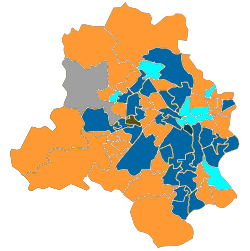
The Delhi Legislative Assembly election was held on 4 December 2013, with the result announced on 8 December resulting in formation of the Fifth Legislative Assembly of Delhi.
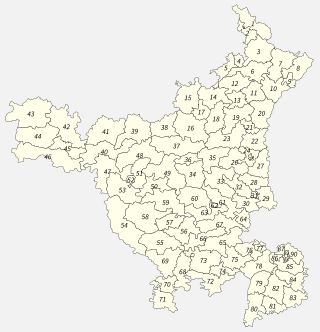
A general election was held on 15 October 2014 to elect 90 members of the Haryana Legislative Assembly. The term of previous assembly elected in 2009 was to expire on 27 October 2014. The results were announced on 19 October. The BJP won the majority in the Assembly. Manohar Lal Khattar was chosen to head the new government.

The Election Commission of India (ECI) is a constitutional body. It was established by the Constitution of India to conduct and regulate elections in the country. Article 324 of the Constitution provides that the power of superintendence, direction, and control of elections to parliament, state legislatures, the office of the president of India, and the office of vice-president of India shall be vested in the election commission. Thus, the Election Commission is an all-India body in the sense that it is common to both the Central government and the state governments.
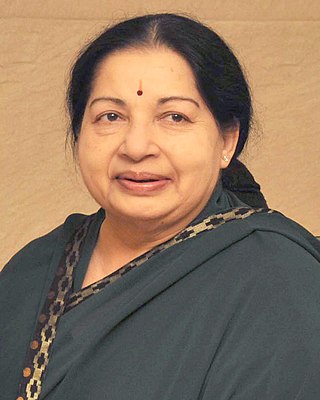
The Fifteenth Legislative Assembly Election was held on 16 May 2016 for the 232 seats of the Legislative Assembly in the state of Tamil Nadu in India. AIADMK under J. Jayalalithaa won the elections and became the first ruling party to be re-elected in Tamil Nadu since 1984, though with a simple majority. DMK won half of the seats it contested but its allies performed poorly; notably, the Indian National Congress won 16% of the seats they contested and the alliance lost due to its poor performance. The votes were counted on 19 May 2016. In the previous election in 2011, AIADMK, under the leadership of Jayalalithaa, won a thumping majority and formed the government, while DMDK chief Vijayakanth served as the Leader of Opposition until January 2016. This was the last election that J. Jayalalithaa and M. Karunanidhi contested, as they both died in 2016 and 2018 respectively.
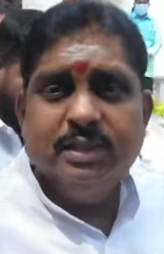
The legislative assembly election in the Indian union territory of Puducherry was held on 16 May 2016 to elect members of the 30 constituencies in the non-contiguous territory to constitute Fourteenth Puducherry Legislative Assembly.
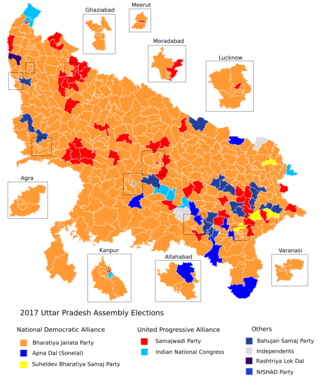
The election to the 17th Uttar Pradesh Legislative Assembly was held from 11 February to 8 March 2017 in 7 phases. This election saw a voter turnout of 61.11% compared to 59.40% in the previous election. The Bharatiya Janata Party (BJP) won the election by an overwhelming three-quarters majority of 325 seats despite not projecting a chief ministerial candidate before the election. As part of its election strategy, BJP contested under a collective leadership and capitalised mostly on the political clout and 'brand' of its leader Narendra Modi.

A Legislative Assembly election was held in the Indian state of Punjab on 4 February 2017 to elect the 117 members of the Fifteenth Punjab Legislative Assembly. The counting of votes was done on 11 March 2017. The ruling pre-election coalition was the alliance comprising the political parties Shiromani Akali Dal and Bharatiya Janata Party and led by Chief Minister Parkash Singh Badal. The voter turnout for the Punjab Assembly election was 77.2% The Indian National Congress led by former Chief Minister Captain Amarinder Singh defeated the ruling alliance and the newcomer Aam Aadmi Party.

The Himachal Pradesh Legislative Assembly election, 2017 was held on 9 November 2017 to elect all 68 members of the Himachal Pradesh Legislative Assembly.
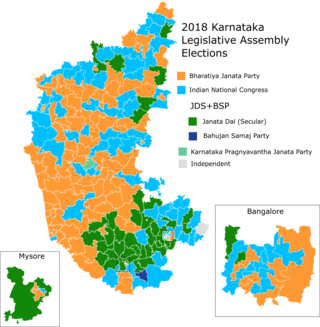
The 2018 Karnataka Legislative Assembly election was held on 12 May 2018 in 222 constituencies to the Karnataka Legislative Assembly. The election was postponed in Jayanagar and Rajarajeshwari Nagar, following the death of the MLA B. N. Vijaya Kumar and a voter fraud scandal respectively till 28 May. The election saw a voter turnout of 72.13 per cent, the highest in Karnataka since 1952 assembly polls. The counting of votes took place on 15 May 2018.

The 2021 Assam Legislative Assembly election was the 15th quinquennial legislative assembly election held in the Indian state of Assam from March 27 to April 6 in three phases, to elect 126 MLAs to the 15th Assam Legislative Assembly. The votes were counted and the result declared on Sunday, 2 May. The term of the previous Fourteenth Legislative Assembly of Assam ended on 31 May 2021.

Legislative Assembly elections were held in Uttar Pradesh from 10 February to 7 March 2022 in seven phases to elect all 403 members for the 18th Uttar Pradesh Legislative Assembly. The votes were counted and the results were declared on 10 March 2022.
Nandigram Vidhan Sabha constituency is an assembly constituency in Purba Medinipur district in the Indian state of West Bengal. The General election to the Legislative Assembly of West Bengal for 292 constituencies out of the 294 constituencies in West Bengal was held between 27 March to 29 April 2021 in eight phases. Voting for the two remaining constituencies was delayed and was scheduled to be held on 16 May 2021. Polling in Nandigram took place on 1 April.
Electronic voting machines (EVMs) were introduced in Bangladesh to resolve problems of using paper ballots. They were first successfully used in 2007 for the election of the working committee of Dhaka Officers' Club. Since then, EVMs have been used sparingly in various city corporation elections in the country. In 2018 they were used in six constituencies for the first time in a general election.
References
- ↑ "The need for a 'totaliser' revolution". The Hindu .
- ↑ "New Voting Machine For Extra Secrecy Nixed By Government".
- ↑ "Govt opposes voting pattern veil". Archived from the original on March 12, 2017.
- ↑ "Know Your Electronic Voting Machine" (PDF). Retrieved 2010-09-01.
- ↑ "EC rejects Maya's EVM charges, machines are fool-proof, says commission". The Times of India .
- ↑ "EC for new machine to enhance voter secrecy". The Hindu. 3 April 2015.
- ↑ "Ministers reject EC bid for device to hide voting trends". 18 February 2017.
- ↑ "EC plan to use 'Totaliser' rejected". 24 October 2016.
- ↑ "New counting method for Assembly polls".
- ↑ "What EVM Tampering Debate Is Totally Overlooking".
- ↑ "Election Commission proposes machines to mask voting pattern, Govt shoots it down". 13 January 2017.
- ↑ "Pursuit for poll reforms will continue: Chief election commissioner Nasim Zaidi". 5 March 2017.
- ↑ "Elections: Why is the BJP opposed to the 'Totaliser' machine?". 11 March 2017.
- ↑ "Protect the voter: Introduction of totaliser machines a positive for electoral processes". 30 August 2016.
- ↑ "Govt rejects Election Commission proposal for machine to hide voting pattern". 17 February 2017.